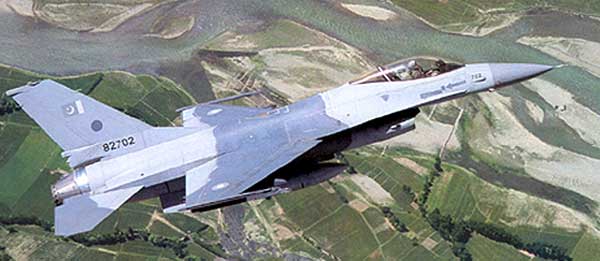News Analysis |
Lockheed Martin has agreed to jointly build F-16 fighter planes equipped with new-generation electronics in India with Tata Advanced Systems Ltd.
The fighters are of the Block 70 type, “the newest and most technologically advanced F-16 ever.” The Indian air force does not currently use F-16s, but this joint production project would enable India to procure one of the most used and advanced fighter jets.
Read more: SCO membership of India & Pakistan brings challenges and opportunities
India is the world’s largest arms importer, and will likely have the third-largest defense budget in the next quarter-century.
Indian Prime Minister Narendra Modi has moved to reduce India’s reliance on expensive imports and called for the manufacturing of defense equipment locally. This agreement between Tata Advanced Systems Ltd and Lockheed Martin seems to be a step in that direction.
India is already overhauling its military forces and is conducting a $100-billion upgrade of its Soviet-era military hardware. India has border disputes with its northern and western neighbors, China and Pakistan and has increased its defense budget to counter threats to its national security.
India’s defense budget, which is approximately more than $53 billion is much larger than Pakistan’s $8.7 billion which gives it a massive edge over its small neighbor.
India’s defense budget is growing at an impressive clip, but rising personnel costs are crowding out resources for modernization. Since the mid-2000s, an increasing share of India’s defense budget has been dedicated to pensions and personnel costs, while capital outlays investments in weapons systems are decreasing relative to the rest of the budget.
Strategic competition in South Asia
The strategic competition between India and Pakistan is evolving. India’s relative advantage in terms of comprehensive national power is growing and will continue to grow. Against this backdrop, both countries are developing and expanding an array of nuclear weapon capabilities.
Read more: Can India actually win a war against Pakistan?
Pakistan has preferred to focus on the development of its nuclear arsenal.
Despite the development of nuclear arsenal, both the countries are enhancing the conventional military capabilities. India’s defense budget, which is approximately more than $53 billion is much larger than Pakistan’s $8.7 billion which gives it a massive edge over its small neighbor. However, Pakistan’s strategic relationship with China and its massive economic investment in the form of CPEC project has neutralized to a great extent the Indian military advantage over Pakistan.
To counter India’s growing military capabilities, Pakistan has preferred to focus on the development of its nuclear arsenal. Pakistan spends 10% of its defense budget on nuclear cache while India spends only 3%. Nuclear weapons can serve as a substitute for expensive conventional programs and force structures. This dynamic would be particularly appealing to a country, like Pakistan, that faces an adversary with a substantial resource advantage.
India is the world’s largest arms importer, and will likely have the third-largest defense budget in the next quarter-century. India outspends Pakistan by a ratio of seven-to-one on defense, and this ratio will increase in the years ahead. This resource imbalance will likely cause dilemmas for military leaders and planners in Pakistan. They face an increasingly stark choice between spending for conventional forces and internal security on the one hand, and nuclear weapon-related capabilities on the other.
Read more: Increasing anti-Pakistan rhetoric: What is making India more adventurous?
What should be Pakistan’s line of action now?
In 2016, India and USA signed Logistics Exchange Memorandum of Agreement (LEMOA). This agreement laid the groundwork for the recent agreement between Tata Ltd and Lockheed Martin. It has also brought India and USA closer to each other.
Pakistan has successfully inducted the indigenous JF-17 Thunder aircraft in its infirmary. It is also producing Al-Khalid tanks and other heavy weapons.
Pakistan relies heavily on US military hardware to cater to its defense needs. The military high command of these two States cooperates closely and regularly visit each other military headquarters. But, increasing ties between India and USA have put pressure on Pakistan to find new suppliers of weapons. Russia is a plausible option since its relationship with India is bound to be hampered due to the latter’s leanings towards the USA, which is Russian rival in Eastern Europe and now the Middle East as well.
China can also provide military hardware to Pakistan but the quality of it is not at par with US, Russia or European weaponry.
Read more: NSG membership: Will Russia “convince” China to vote in India’s favor?
The best possible option for Pakistan is to rely on its own military industrial complex. Pakistan has successfully inducted the indigenous JF-17 Thunder aircraft in its infirmary. It is also producing Al-Khalid tanks and other heavy weapons. Pakistan is also an exporter of military hardware to third world countries. Azerbaijan and many African countries expressed a desire to buy JF-17 Thunder and Pakistan has already transferred many of these aircraft to these countries. Pakistan must devise a long term strategy to counter growing Indian military capabilities with a primary focus on self-reliance.
The strategic dynamics of South Asia in particular and the world, in general, are changing fast. Nation states are realigning themselves to protect their security and economic interests. Pakistan should devise an effective foreign policy and play smartly to navigate the complex international politics. Reliance on domestic resources should be enhanced to cater to its defense and economic needs.














